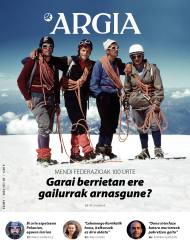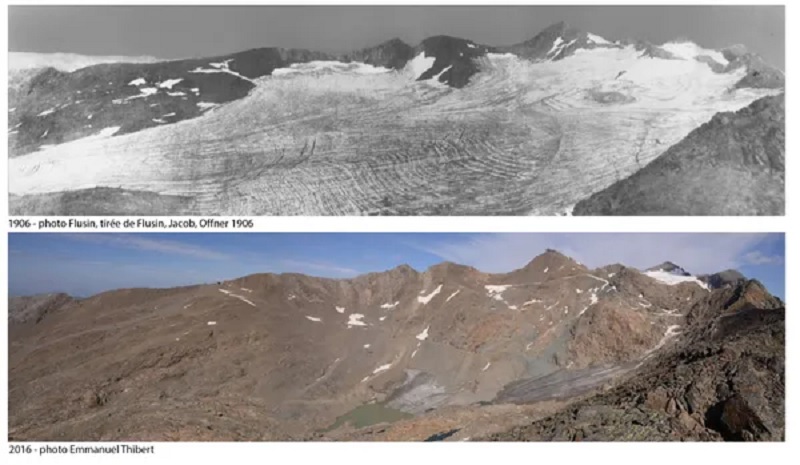Ropes tensioned to maintain the culture of the mountain
- The Basque Mountain Federation will be 100 years old on 18 May. Founded in 1924, the centenary has enabled us to address the evolution and future challenges of mountaineering. There are more people on the mountain than ever before, and the way to understand it is changing in the evolution of society.

The Basque Mountain Federation, officially the Basque Federation of Alpinism, was created on 18 May 1924 by members of the mountain associations of the four territories of Hego Euskal Herria. He performed his foundational act in Elgeta, in a parallel house to which later was called Plaza de los Montañeros, there is a small plate that remembers this fact, along with another that witnesses the past: Camino de los Gudaris.
With the advent of the twentieth century, mountain associations began to flourish, as did other activities related to sport and leisure, largely with the hands of men of good social standing. However, when speaking of the history of Basque mountaineering, some place the starting point in Ethiopia, when in 1848 the Basque Minister Anton Abadia raised Mount Buahit (4,437 meters) to carry out cartographic studies. To give a new date, 1914 is also mentioned with some assiduity, because in this area a competition was organized by some mountaineers, with the challenge of raising fifteen cimes, and then the first mailbox, in Anboto, a witness to the achievements of the mountaineers.
Until then the mountain was related to need, to work, to livestock and to cultivation, to hunting. With the creation of associations and the Federation, other ways of approaching the mountain to become fashionable began to spread. Along the way, mountaineering has lost some of its own components and won new ones.
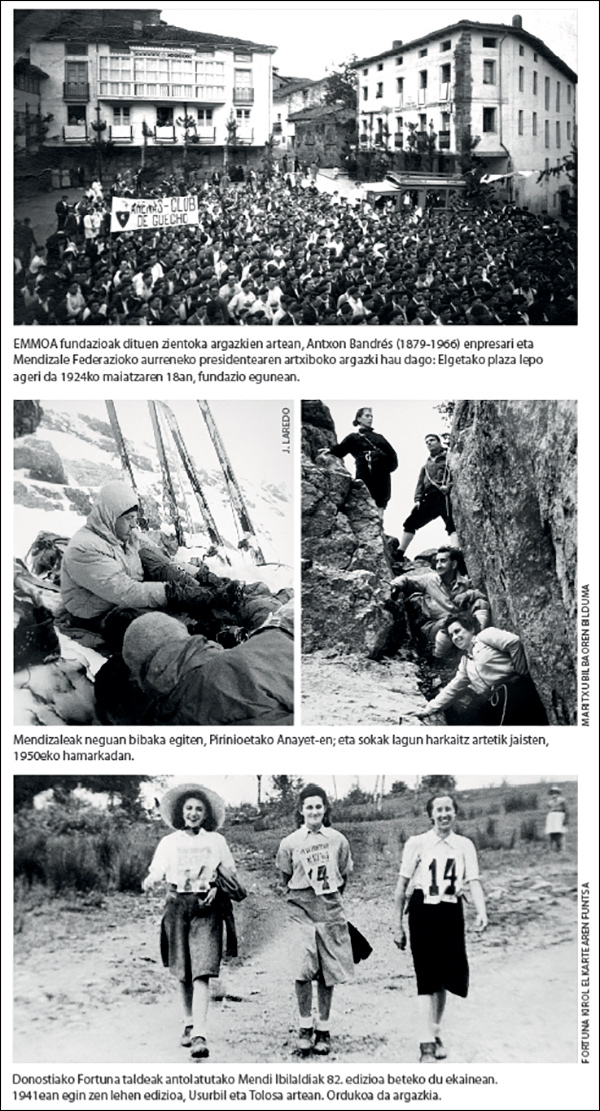
“Being a member of the mountain group Padura de Arrigorriaga, at the age of 14 I was named responsible for the material, I was in control of the crampons, piolets and others that rented the partners. But today each one has its material, we are connected to the Internet...”. What he talks about is Zigor Egia, president of the Basque Mountain Federation since March 2021. Iñaki Garai, technical director of the Federation, has also attended the meeting we convened in Amurrio. They've talked to us about what mountain groups are doing, or have, about the task of transmission, about the consequences of not having a relay, about old books and maps and about today's mobiles and GPS devices, about the effort of organizing a 40-person tour and about the individualism that is splashing every corner. The mountain changes with society.
“We will have to learn to adapt to the new times,” says Egia: “It is a great challenge, not only for mountain associations, but also for the Federation. We have certainly been very Taliban in the face of some changes, we are aware of this, but we are making the transition taking into account the particularities of each modality. For example, in mountain skiing women are getting good results.” Alpinism, northern march, climbing, mountain racing -- the Federation is diverse.
Talking about the evolution of mountaineering is inevitable to talk about the sliding mountains, “athletes” which, in the opinion of many, have also brought competition to the mountains. Zeanuri Gotzon Idirin is one of them, although concerned about the direction mountain racing has taken, he has opted for another model, along with other runners and organizers to create the Green Label manifesto for ethical careers. “I discovered the racing world about fifteen years ago, and over time I have seen that it has undergone a mutation, that it has evolved into competition and has become fashionable. And it attracts people who were unrelated to the mountain. That is not bad, far from it, but I think there are people who have not internalized mountain education or culture. They have come from other sports, such as athletics or triathlon, and a competitive vision is being imposed.”
More than 40,000 people are licensed from the Basque Federation and about 14,000 from Navarra. The amount is huge, considering that there are many people who are not federated.
He was one of the founders of the Gorbea Suzien. After several years he left the work team to later start organizing the Ubidestrón. “A race is a race, competition is inevitable, but how? 15-20 years ago it was unthinkable for a runner to get injured and not stay to help, for example. The races live under great pressure, cases of doping have appeared... The mountain is for us a respiratory zone, and we worry about extrapolating some values.” As an example, Behobia-San Sebastián is celebrated in the urban center: “Although it brings together thousands of runners and spectators, it doesn’t have so much environmental impact.”
Meet the people to want it
Veteran Mountaineer and journalist Antxon Iturriza is a member of the EMMO foundation, Museum of the Basque Mountain: “Things are changing. He was not well seen running through the mountain and is now fashionable. The mountain had, say, a romantic touch, and I think today is more of a sport.”
This year more than 40,000 people are licensed from the Basque Federation and about 14,000 from the Navarra Federation. In Hego Euskal Herria 55,000 people, the amount is huge, considering that there are many people who are not federated that go to the mountain.
“It has never been so federated,” says Iturriza. “After Franco’s death, the licenses fell through the entrance of the youth. In remote times, in the Second Republic this was also the case, ‘more important’ issues become stronger than leisure activities.” In his opinion, however, Basque mountaineering carries in its veins a “political reparation” which, beyond the mere practice of sport, has meant for many a space of freedom. “Political demands on the street were often impossible. Tell me, teach, sing... We used to see an ikurrina at the top, and we felt a terrible emotion, because its exhibition was banned. Mountaineering and nationalism are united because in the crossings the country is known.”
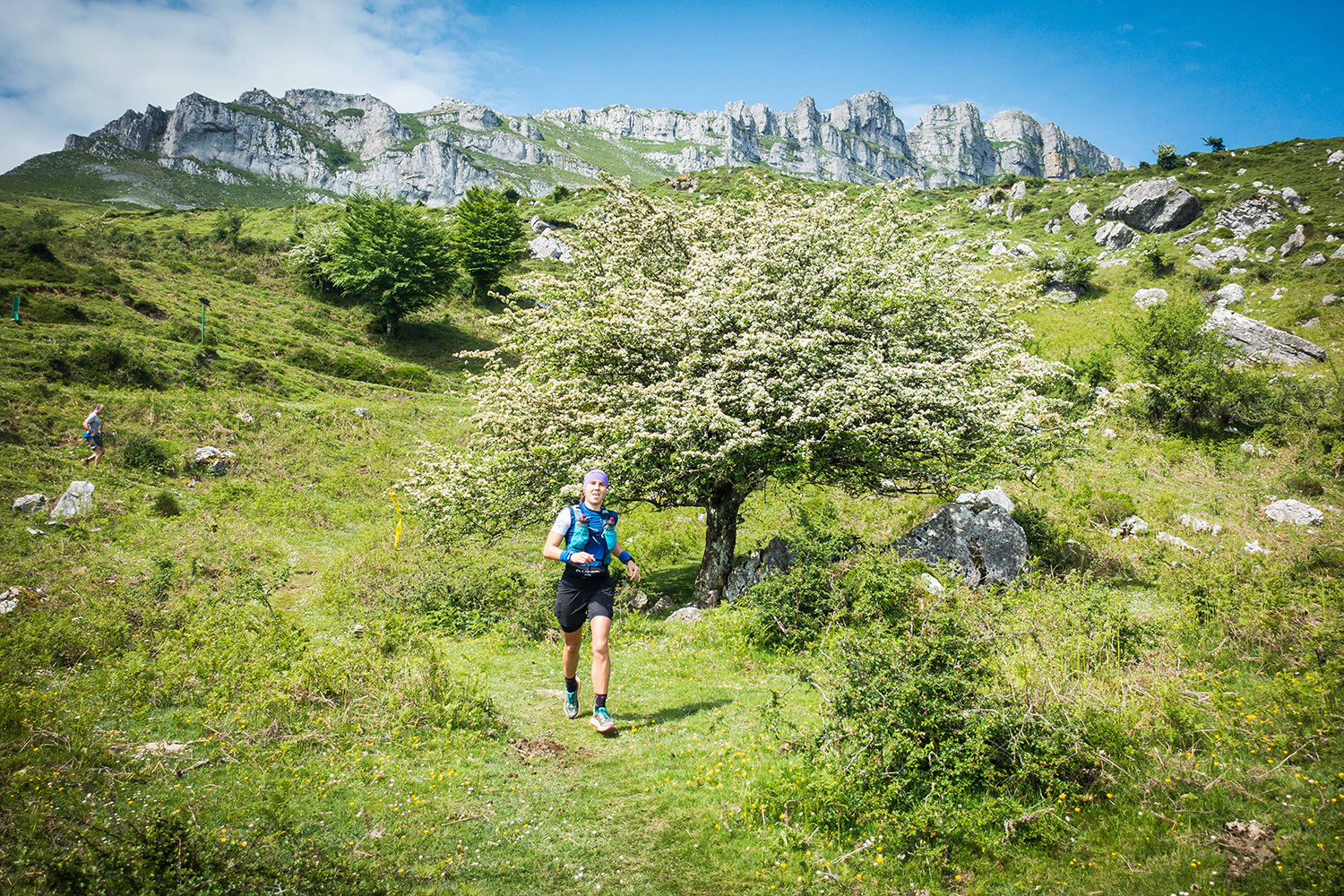
Along the same lines, the president of the Federation, Zigor Egia, says that in order to love the people it is necessary to know, to know the places and the actions of the people living in it, such as pastors or farmers. “And I would say that this is what the Federation has driven since its foundation, to walk the mountain to meet and love the people.”
“Races often pass through private places, forests, grasses…”, can be read in the Green Label manifesto. “There are people who live and work, like pastors. We think it is very important that this be present.” And a little further down: “In order to enhance and know the cultural heritage of the valley or people, it is proposed to organize special activities, such as praising the work of pastors, showing the places that constitute the patrimonial core, recovering toponymy...”. The recommendations are equally valid for street children carrying loose dogs or for those leaving the car anywhere.
“We don’t run for money”
“We live faster, individualism has gained strength and we often put the individual ahead of the community,” the manifesto states. “Today, together with the evolution of society, we have detected a change in the direction of careers. Many have been mediatized, we can say that they have become fashionable, and that has caused many of the values we met to be lost on the way.”
Concerned about this evolution, several runners and organizers started a reflection that led them to create the Green Label. The close to 40 races, almost all of them from Euskal Herria, today form the initiative and the promoters expect more short-term tests. Careers that adhere to the project, in order to ensure a “respectful relationship” with nature and other athletes, must take into account a number of recommendations and comply with concrete commitments.
Gotzon Idirin (Green label): “There is no mountain culture; if the cell phone runs out of battery, nobody knows where it is.”
In the decalogue, on the one hand, there are measures that can be taken by any sporting event: that the nature of the sponsors be as ethical as possible; that as far as possible the meals and drinks of the ration posts are indigenous and ecological; that minority languages are prioritized; that trophies are non-stereotyped from the gender perspective; that non-sexist music is painted; etc. Furthermore, mountain racing organisers must be taken into account. For example: if the route crosses a natural park or an ecologically vulnerable area, the maximum number of participants will be 500; spectators will be called so that they do not accumulate in those places; those who deny assistance to the corridor that needs it will be the layoff, those who throw a gel on the ground; the ‘elite’ corridors will have no privileges – they will have no different classifications, tours or prizes – the prizes will not be able to exceed the 1.5 kilometers of €. “We don’t run for money,” says the Green Label decalogue.
Despite the fact that these are mountain races that are largely marking the evolution of mountaineering, the Federation’s technician, Iñaki Garai, has reminded us that only 10% of its athletes are runners. “In the media and social networks there are those who participate in the selection, but the federation is much broader. I would say, on the other hand, that the world of competition is R & D & I in companies, a window of development in mountaineering.” But the mutation hasn't come suddenly. “The model is changing since climbers migrated to Everest in the last century.” The members of the EMMO Foundation have shown us a picture. Half a dozen men are observed in the shorts in a slight error slope: “Pioneers of mountain racing in Pagasarri, 1912”. It's been over 100 years since then.
“The Basques carry the mountaineering in the DNA, in every house there are backpacks and boots,” says Egia. “Orography is part of us. My father, for example, had to travel several kilometers downhill to go to school.” Today it is an eminently sporting or leisure activity, it is attracting many people and it is normal that some people do not have sufficient knowledge. In this sense, among many other projects, the federation has launched security campaigns, even in schools, to explain how to prepare to go to the mountain (look at weather forecasts, say where we are going, measure forces...), because they have seen that in a few years the number of rescues has tripled, up to ten warnings a day.

Gotzon Idirin is a firefighter of difficult rescue. “We are seeing more and more mountaineers. There's no mountain culture; if the cell phone runs out of battery, nobody knows where it is. And so it's equipped. When I snoop I often go to the Gorbeia area, and in the face of the panorama I have become famous there many times, afraid to start working. I'm a study geologist, and I think one of the most beautiful things that mountain has is its ability to make us feel small. However, there are people who are able to do anything, they are not aware that a change of time can crumble everything. The mountain must be respected.” Also to the past.
They're not treasures.
“We are a little bit ignorant in our history,” says Antxon Iturriza, a member of the EMMO Foundation, while pointing out the boxes of packed objects stacked in Martutene’s offices. The museum project began twenty years ago with the objective of collecting and publicizing the heritage, and after several attempts, it is possible to inaugurate it in the short term in the Arkaute de Tolosa house.
“It has been a longer process than I expected,” says Iturriza. “We thought he would introduce the project and surprise everyone, but you realize that to fulfill a dream you need money... Although the City of Tolosa has shown a very positive attitude, we need the support of more institutions.” There is also another problem: “Who takes our witness? We are advancing in age, we are working reluctantly, and if we want the museum to stabilize, it will have to be professionalized in part, because we are not at the best time to seek volunteers.” Volunteering, militancy, transmission, concern shared by associations and groups from different areas. Gotzon Idirin addresses the project of the Green Label when the needs of each other allow it, and the Criminal Truth itself, president of the federation, is also not paid: “I had a debt to mountaineering because it has helped me in difficult times. Some are climbing eighty and others have to do political mountaineering. Everyone has to contribute what they can, that commitment I have seen at home, both in the creation of the ikastolas and in the work of mountain team...”.
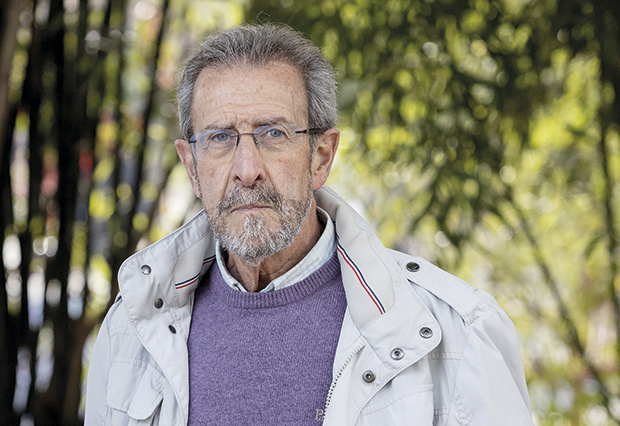
APS stores much of the material accumulated for years in two rooms of a building in the 27 Martutene polygon. They have documents in an office (books, newspapers and magazines, photographs, guides, maps...) and mountain material (piolets, skis, shampoos, boots, crampons...). Among them are the crampons and wood skis of Maritxu Urreta, founder of the Basque Camping Club, the mountaineer Trini Cornellana on her unfortunate expedition to Shakhauri (Afghanistan), the first woman to climb the mountain, which Gregorio Ariz wore in 1979 with the Basque botoot to climb a city in Eversa. An impressive treasure, captivated in eleven boxes.
In defense of the mountains
The newspapers and posters listed in the document section have enabled us to dialogue with the acts called in defense of natural spaces. “I remember that around 1975 the Cuidemos de Belagua campaign was launched, because they wanted to build a ski resort and an urbanization,” says Iturriza. “No harm than they did, because of their impact on the environment, especially when they do not deny enough to keep their business. The question of wind power is now pil-pil. And alien tree species have been introduced, cement roads have been made, VAT ... The human being is an aggressive species, we are continuously beating, intervening and transforming nature. There are usually different interests in the game and...”.
The members of the Mountain Federation explained to us that in the assembly they were asked how to position themselves before wind and similar: “In our statutes it is written that we have to defend the mountains,” explains Egia. “We are in favour of renewables, where and how? We have to look at the situation in each case, but in principle we do not want more electric towers, windmills or roads.”
“The impact of this kind of mega-projects is demasa,” complains Gotzon Idirin, from the Green Label. “Look at the massacre that the TAV is doing in the Duranguesado. When you put money or nature in the balance, the loss is always nature. The issue of eucalyptus has also influenced, in short if we seek immediate economic benefits... Heritage is not just this house or whatever, but building a better world for our children.”
Local authorities usually authorize the economic impact that the “people” will receive back to justify the insatiable thirst for organizing sports events, and the mountain is not an “exception”, although it should be, according to Idirin: “For racing organizers it is good to accumulate people in emblematic places because it leaves spectacular images, but it is not sustainable, it is not sustainable to want to enter protected environments like the biotope Itxina, because it is a nice place.”
What will our mountains look like in 100 years? Where is mountaineering going? Where do they compete? What is the fate of mountain federations and associations? Who knows? However, several agents work by a model that prevents these respiratory areas from drowning. Good years.
---------------------------------------------
Union of the two federations
It was founded in 1924 by mountaineers from Álava, Bizkaia, Gipuzkoa and Navarra. For many years they were built together, until the autonomous laws that entered into force in the 1980s separated the federations of the Basque Country and Navarre. 40 years later, the Mendialdea programme was drawn up jointly, and at the cost of that, about three years ago, work began on the constitution of the Basque Country Herriko Mendi Biltzarra, as a model for structuring the Federation of Ikastolas or the Bertsolaris Association.
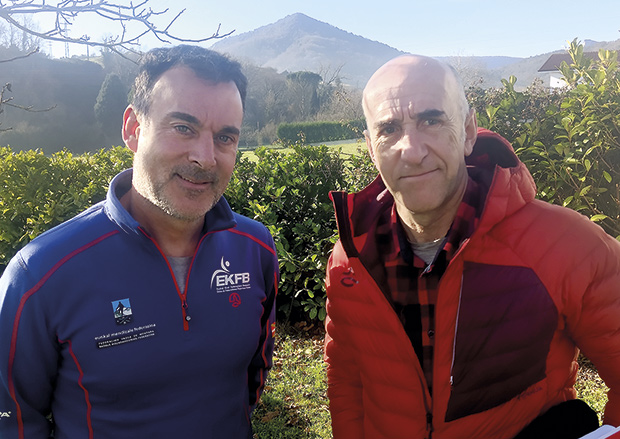
The congress will channel the accounts linking the two federations: Revista Pyrenaica, Memory Day of Besaide, March to the Basque Centre, Centenarians... It is precisely on 18 May, on the anniversary, that the new entity will be presented in Elgeta. In addition to the two federations, APYMA also has representation in the congress, and it is possible that some agent from the continental Basque Country will join.
---------------------------------------------
Mendirena.
The centenary programme of the Federation is rich. Among other things: on 16 March the mountaineers of the seven territories will climb six peaks of Euskal Herria; on 20 March the Korrika will pass through Elgeta and the mountaineers will take one kilometre; on 27 and 28 April a 100-year mountain initiative will be held in which more than a hundred Basque mountain groups will rise 100 peaks; on 18 May a special event will be held.









